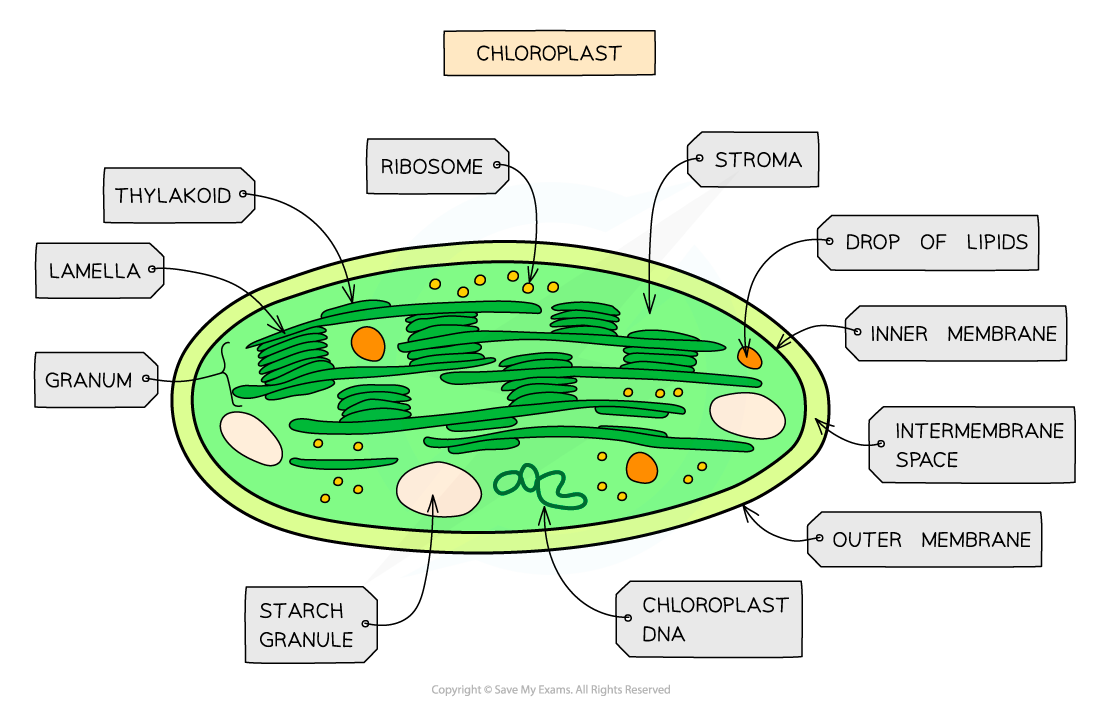- 翰林提供学术活动、国际课程、科研项目一站式留学背景提升服务!
- 400 888 0080
IB DP Biology: HL复习笔记8.3.5 Chloroplast
Chloroplast Structure & Function
Structure
- Chloroplasts are the organelles in plant cells where photosynthesis occurs
- These organelles are roughly 2 - 10 μm in diameter (they are larger than mitochondria)
- Each chloroplast is surrounded by a double-membrane envelope
- Each of the envelope membranes is a phospholipid bilayer
- The outer membrane is permeable to a range of ions and small molecules
- The inner membrane contains transport proteins that only allow certain molecules or ions to enter or leave the chloroplast
- Chloroplasts are filled with a cytosol-like fluid known as the stroma
- CO2, sugars, enzymes and other molecules are dissolved in the stroma
- If the chloroplast has been photosynthesising there may be starch grains or lipid droplets in the stroma
- A separate system of membranes is found in the stroma
- This membrane system consists of a series of flattened fluid-filled sacs known as thylakoids
- The thylakoid membranes contain pigments, enzymes and electron carriers
- These thylakoids stack up to form structures known as grana (singular – granum)
- Grana are connected by membranous channels called stroma lamellae, which ensure the stacks of sacs are connected but distanced from each other
 Chloroplast structure
Chloroplast structure
- The membrane system provides a large number of pigment molecules that ensure as much light as necessary is absorbed
- The pigment molecules are arranged in light-harvesting clusters known as photosystems
- In a photosystem, the different pigment molecules are arranged in funnel-like structures in the thylakoid membrane
- Each pigment molecule passes energy down to the next pigment molecule in the cluster until it reaches the primary pigment reaction centre
Adaptations of chloroplasts to photosynthesis
- Stroma:
- The gel-like fluid contains enzymes that catalyse the reactions of the light-independent stage
- The stroma surrounds the grana and membranes, making the transport of products from the light-dependent stage into the stroma rapid
- Grana:
- The granal stacks create a large surface area for the presence of many photosystems which allows for the maximum absorption of light
- It also provides more membrane space for electron carriers and ATP synthase enzymes
- DNA:
- The chloroplast DNA contains genes that code for some of the proteins and enzymes used in photosynthesis
- Ribosomes:
- The presence of ribosomes allows for the translation of proteins coded by the chloroplast DNA
- Inner membrane of chloroplast envelope:
- The selective transport proteins present in the inner membrane control the flow of molecules between the stroma and cytosol (the cytoplasm of the plant cell)
- Thylakoid space:
- This is where a proton gradient develops (to generate ATP)
- The space has a very small volume so a proton gradient can develop very quickly
转载自savemyexams

最新发布
© 2025. All Rights Reserved. 沪ICP备2023009024号-1









